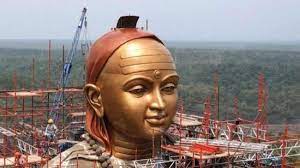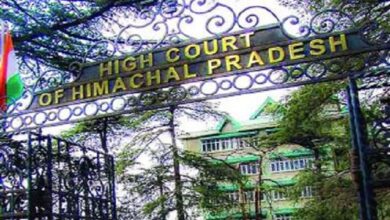The 108-Foot Adi Shankaracharya Statue’s History, as Revered by CM Shivraj Chouhan
On Thursday, September 21, in the holy city of Omkareshwar, Madhya Pradesh Chief Minister Shivraj Singh Chouhan presented a massive 108-foot monument of the Hindu saint and philosopher Adi Shankaracharya. This magnificent sculpture, known as “Ekatmata Ki Pratima” or “Statue of Oneness,” is a colossal tribute to Adi Shankaracharya’s long legacy and insightful teachings. According to an official source reported by the news agency PTI, the event had to be postponed from the original unveiling date of September 18 owing to severe rain in the area.

This imposing building was developed under the direction of Acharya Shankar Sanskritik Ekta Nyas and the Madhya Pradesh State Tourism Development Corporation (MPSTDC) and is located atop the picturesque Mandhata hill, overlooking the Narmada river in Khandwa district. It honors Adi Shankaracharya’s life and philosophy as well as his important contribution, the commentary on “Brahmasutrabhasya,” a key book of Hinduism’s Vedanta school that emphasizes the idea of Oneness.
The managing principal of CP Kukreja Architects and the architect behind this cultural project, Dikshu Kukreja, told PTI that “this extraordinary structure, conceptualized to honor the life and philosophy of Adi Shankaracharya, is a tribute to the great saint’s masterpiece of commentary on “Bharmasutra-bhasya.”
“This cultural project will realize Prime Minister Narendra Modi’s much-loved vision of ‘Vasudaiva Kutumbakam (The world is one family’),” he said. With the completion of this 108-foot-tall monument, Madhya Pradesh will solidify its status as a cross-religious center of culture and spirituality.
An earlier proposal for Rs 2,141.85 crores that included building an Adi Shankaracharya monument and a museum at Omkareshwar was approved by the Madhya Pradesh BJP government.
The idea for this monument project first emerged in 2018, when Sholapur-based artist Vasudev Kamath came up with the original sketch. In order to gather the required metal for creating the monument, a large public protest and processions known as the “Ekatma Yatra” included engaged community involvement and covered over 23,000 gram panchayats throughout the state. This unique cooperation perfectly captures the spirit of a public-private partnership.
According to News 18, Madhya Pradesh Chief Minister Shivraj Singh Chouhan spoke warmly of Adi Shankaracharya’s outstanding accomplishments during an interview with veteran editor and writer Vithal C Nadkarni. Chouhan emphasized Shankaracharya’s contribution to the unification of the Bharat-varsha area, not only via his Advaita Siddhanta monistic theory but also through the founding of four strategically placed spiritual mathas or monasteries around the nation.
India’s spiritual landscape was characterized by the existence of six main sects during Shankaracharya’s time, which occurred in the ninth century. The Mother Goddess was worshipped in one of them, while Surya, Vishnu, Shiva, and Ganesh were worshiped in the other four. The god Skanda-Kartikeya, also known as Murugan among the Tamil people in Tamil Nadu and other parts of South India, Sri Lanka, Singapore, Malaysia, and Mauritius, was the focal point of the sixth sect. The great influence Adi Shankaracharya had throughout his 32-year life is shown by his substantial efforts to bringing these disparate components within India’s spiritual environment into harmony.







